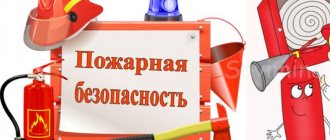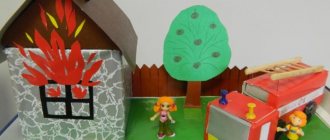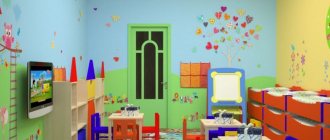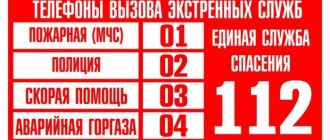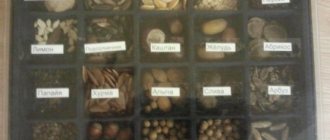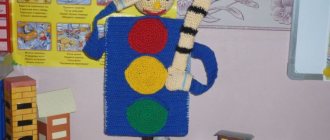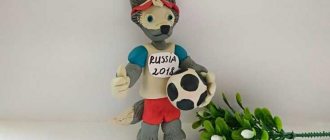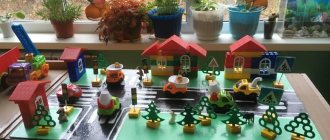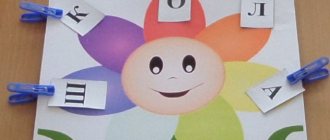Craft material
A lot of experience has been accumulated in such games. If you look at the photos of traffic crafts, you can see that making them is not difficult.
Parents will help children at home, and teachers will help children in child care institutions. Anything is suitable as a raw material: colored and white paper, cardboard, boxes, plastic bottles and their caps, old CDs, plasticine, toothpicks, tape. You will also need pencils, markers, paints, brushes, glue, and scissors.
Where to start
It is important to create a scenario that involves you in the creative process, and then working together will become useful and educational. Gradually, the child will remember the norms and realize that:
- At the “Pedestrian crossing” arrow, you must not let your guard down;
- First you need to make sure that all transport has stopped;
- when walking, look to the left, and when you reach the middle, look to the right;
- It is forbidden to play near the road, even if it is in the yard.
We create a mini-city for studying traffic rules
The layout has a complex design. It will turn out large and voluminous, but its creation will require few materials. This craft on the topic of traffic rules will be a good teaching material. The mini-city is made from cardboard and colored paper using watercolor paints, brushes, scissors and glue.
Technique for making a city model
- Prepare cardboard boxes of different sizes. Cover them with colored paper and decorate them with windows cut out of plain white paper.
- Cut off the top of a large box and decorate its bottom according to the plan of the future city.
- If the project includes a river, paint it blue or cyan.
- Paint the road black and apply white markings.
- Cut out circles from cardboard and draw traffic signs on them. To install next to the road, glue it to a wire stand.
- A traffic light is created from a cardboard rectangle onto which colored circles are glued: red, yellow and green.
- You can stretch a wire across the road to serve as a wire for suspended traffic lights. Its ends are glued on top of the houses.
- Make trees, shrubs and flowers from plasticine. Create additional elements: benches in the courtyards, a bridge across the river, a fountain.
This craft will help you not only learn safety rules, but also colors. To make the layout more realistic, use Lego figures and toy car models.
Public or specialized transport can be created from matchboxes with colored paper glued to them. Instead of headlights, small buttons are glued to the boxes.
City layout for the game
Instead of a big city, you can create a small structure for playing traffic rules, which is suitable for preschool children:
- Cut a playing field out of a large cardboard box, place houses and signs on it, and crosswalks across the road.
- Come up with an interesting task for the pedestrian.
- You can use Kinder figures as characters.
- Cut and glue the game cube, placing the required number of dots from one to six on each side.
Have a nice trip and enjoy your time!
At what age to start
Even a small child can make DIY traffic crafts from paper or cardboard. This process not only develops hand motor skills and spatial imagination, but also brings new information.
For example, by drawing or gluing together a traffic light, a child will remember the colors of the lanterns, and with the help of an adult’s explanations, he will learn that red signals danger and one must stand, yellow means readiness, and one can go only when the light turns green.
How to make a traffic light
There are many options for manufacturing. It can be made in the form of a paper or plasticine applique on a landscape sheet or on a tube from a toilet paper roll, or on a box, for example, from a juice box.
Any available or junk means will do. A little imagination is enough to arouse the interest of a child. And then the vital rules will be remembered quickly.
Idea No. 1. Traffic light
The first thing every child should know is traffic signals. Making such a craft is not difficult at all and quite quickly.
We will use environmentally friendly materials that are accessible to everyone.
So, to make a traffic light with your own hands we will need:
- colored paper in red, yellow and green;
- A4 sheet;
- PVA glue (we used a glue stick, it is more convenient for gluing paper);
- scissors;
- an empty rectangular box (in our case, toothpaste);
- pencil;
- ruler;
- an awl or other tool to pierce a hole in the box;
- a compass or round object for drawing circles (we took a cream lid;
- balloon leg (optional).
Next, on a sheet of paper with a simple pencil, mark lines in accordance with the dimensions of the box.
We used a white sheet, but in the end we thought that gray paper would work well - it would make the traffic light more realistic. For young children who find it difficult to draw, you can prepare templates in advance.
Using scissors, we cut out the future “wrapper” of the traffic light, which we will later cover the box with.
Carefully bend the workpiece along the lines so that the corners of the craft are smooth and beautiful.
Lubricate the paper with glue and connect it to the box.
At the base of the body of the future traffic light, mark with a pencil the location of the hole for the leg and pierce it with an awl.
This is necessary if you want to be able to install a traffic light. If you intend for the toy to only hang on the tree, then attach a loop at the top instead.
Next you need to make red, yellow and green circles.
Glue them in the correct sequence onto the body.
We install a leg with a round base into the hole made. We had a balloon leg on hand.
In principle, any stick is suitable for this function, and a stable base can be fashioned from plasticine.
You don’t have to stop there and glue one circle in the color of the traffic light on each side of the traffic light. This addition will be especially relevant if the toy hangs on the Christmas tree. When you turn a traffic light, a certain light will seem to “turn on”, and the child will explain what it means.
How to make a road with a barrier
To do this, you will need to cut a strip of black paper of the required width and glue it onto a piece of cardboard with PVA glue. Cut out barriers from the boxes, wrap them in white paper and paint them with red stripes.
We recommend reading:
Craft bullfinch: detailed description of how to make a bird with your own hands (115 photos)- Crafts from vegetables: 100 photos of the best crafts for children and a review of recipes for adults
- Craft ship: 120 photos, templates, drawings and step-by-step instructions on how to make a boat
Attach to the sides. Make markings depending on the type of traffic: single-lane or two-lane. Draw and display signs. Toy cars will complement the picture.
Road signs for games in the yard
You will need to take white plastic and cut it into the shape of a road sign: round, square or triangular. It is advisable to find an image of the sign on the Internet and print it out. After this, the picture should be transferred to self-adhesive paper, from which a stencil will be created.
Cut out areas that require painting. Glue the rest of the part onto the plastic. Paint the cut out areas with acrylic paint, forming central elements from it. Let the paint dry completely, then remove the stencil.
To disguise the plastic cut, attach a plastic profile to the edges of the sign. It will form a neat white border.
Secure the workpiece to a wooden strip with a cross fixed at the bottom.
Interest turns into knowledge
Crafts for little ones are easy to make. They are made in the form of a three-dimensional object or a flat figure.
Drawing road crossing strips together with children and placing special signs on “paper streets” will help to convey to children the law about moving across roads in strictly designated areas.
When drawing sidewalks, you should explain that they are for people only, and that you should walk on them keeping to the right. During the game, learning occurs naturally and naturally.
Road signs
For older children, road safety crafts are used to introduce road symbols. They are easy to prepare. After drawing on paper, cut out, glue on cardboard and make a base for them from tubes and circles.
We recommend reading:
Crafts weapons - step-by-step instructions for making dummies of weapons with your own hands (105 photos + video)- Crafts of the symbol of 2022: New Year's crafts and tips for choosing a holiday theme (90 photos)
Crafts: the second life of things: ideas for creating beautiful crafts from old things (95 photos)
Such material will help classify signs. The first ones carry information, the second ones make warnings, and the third ones issue a ban.
Wall newspaper
The wall newspaper helps to consolidate the acquired knowledge and will serve as an excellent craft on the topic of road safety. For young intellectuals, it can be designed as a crossword puzzle or a tea puzzle. It can be filled with information about traffic rules competitions or the intricacies of the work of a guard at an intersection.
Master class on making wall newspapers
- Take whatman paper in A1 format and measure its length and width.
- Prepare the plywood and cut it to size, then mount it to the wall.
- On whatman paper, mark places for the main heading, thematic sections and articles.
- Fill the wall newspaper with the necessary material using paints, brushes, markers and pencils.
- Take the buttons and attach the wall newspaper to the plywood.
Our didactic material on the topic of road safety is ready. Teaching staff can be offered to hold a competition to create wall newspapers between school classes. A stand with a colorfully decorated wall newspaper is perfect for a themed event.
Behavior in transport
It is important to teach how to behave correctly in and out of transport. The behavior model is formed during the game with a layout made up of streets, cars, buses, and stops. The little people are molded from plasticine or salt dough.
The child will get a fun idea of how to get on and off the bus correctly, so that in practice the information will be consolidated and gradually become a habit.
Consultation for educators “Using a model to study traffic rules in preschool educational institutions”
Chernysheva Lyudmila
Consultation for educators “Using a model to study traffic rules in preschool educational institutions”
The purpose of the layout: to form the basis for safe behavior of children on the road; prevention of child road traffic injuries.
This model was made by hand. It is a game visual aid for studying traffic rules and road safety for preschoolers.
The layout includes movable elements: figures of different types of transport, traffic lights, road signs, figures of people to play out various scenes.
The layout can be used for individual work with children, as well as for independent children's activities. The layout is stable, easily moved from place to place, serves for a long time and can be available to preschoolers for play at any time.
A layout is an element that organizes an object environment for playing with small toys. It acts as a “trigger” that promotes the development of imagination and children’s creativity, where the teacher, without directly participating in the game, acts as a creator of problem-game situations and an assistant in the implementation of game plans.
Basic concepts and terms for traffic rules:
(we study on the model)
• Street is a part of a city or town with a road, road signs, pedestrian crossings, houses and institutions, schools, kindergartens, etc.
• Road is the part of the street along which cars move, as well as sidewalks, curbs, and median strips.
• The carriageway is the part of the road intended for traffic. The roadway can be one-way (cars move only in one direction) or two-way (cars move in different directions, the boundaries of which are marked by dividing stripes.
• One-way traffic - traffic moves in one direction.
• Two-way traffic - traffic moves in two opposite directions.
• Sidewalk is a part of the road intended for pedestrian traffic, adjacent to the roadway.
• Vehicle - a vehicle designed to transport people and cargo.
• Driver is the person driving the vehicle.
• Pedestrian is a person walking on the sidewalk, side of the road, or crossing the street.
• Road participant - an adult or child who is directly involved in traffic as a pedestrian or driver of a vehicle.
• Pedestrian crossing - a place designated for crossing the street.
• Traffic light - a device for regulating the movement of vehicles and pedestrians across the road.
• Road signs - signs regulating the movement of vehicles and pedestrians on the roadway.
• An intersection is a place where two roads intersect, regulated by a traffic light.
To play with the layout we use didactic games:
"Drivers"
Goal: To introduce children to the rules of the road for drivers.
Brief description: The teacher tells in a playful way where and how the cars should move. And then he asks to show on a model how drivers behave on the road while driving cars?
"Pedestrians"
Goal: To consolidate children's knowledge about the road and the rules of behavior on it.
Brief description: The teacher asks you to show on a model how pedestrians behave on the road? Children pick up human figures. They are pedestrians. Pedestrians cross the road at a zebra crossing or move along the sidewalk. The teacher monitors the correctness of answers and appropriate actions.
"Fulfill the assignment"
Goal: complete the assignment while following safety rules.
Short description: The game is like going to the hospital, visiting or shopping. At the same time, the child tells how he will move. The teacher monitors the correctness of answers and appropriate actions.
"Traffic light"
Goal: to consolidate children’s knowledge about transport and pedestrian traffic lights and their signals.
Preliminary conversation: What types of traffic lights do you know? What do traffic lights mean? What do pedestrian traffic lights mean?
Progress of the game: Turn on the traffic light on the model. Cars and pedestrians move according to the signals of their traffic lights. The teacher monitors the correct actions of pedestrians and drivers.
"Types of transport"
Goal: To consolidate children’s knowledge about types of urban transport (passenger, cargo, special purpose)
Preliminary conversation: Recall the characteristic differences between different types of transport (land, water, air, underground); What type of transport is urban transport? Why?
Brief description: The teacher invites the children to arrange the car figures into groups according to some characteristic (What does it transport? What does it move on? What does it work on? By the presence of special sound signals and beacons).
"Guess the transport"
Goal: to consolidate children’s ideas about transport, the ability to recognize objects by description; develop ingenuity, quick thinking and speech activity.
Material: transport figures.
Progress of the game: The teacher asks the children riddles about types of transport. The first child to guess what kind of transport is being discussed in the riddle gets a figurine. Whoever has the most vehicles at the end of the game is the winner.
"Our street"
Goal: To clarify and consolidate children’s knowledge about the constituent elements of the street (road, houses, trees, roadway, sidewalk, etc.) Developing children’s attention.
Progress of the game: Children examine the layout and list the constituent elements of our street. Children accompany their answers by showing them on a model.
"Find a Safe Path"
Goal: to consolidate the rules of the road and behavior on the road; develop thinking, memory, attention, expand vocabulary.
Preparing for the game: The teacher asks the children: - Is it possible to cross the street everywhere? — What signs indicate that it is allowed to cross the street in this place? — Where and why should you look at the beginning of a street crossing? — Where and why should you look in the middle of a street along which cars are driving in both directions? — What does a pedestrian crossing sign look like and what does it warn about? — Why was a zebra drawn on the road?
Progress of the game: Children look for signs on the model that allow or prohibit crossing the street. They role-play various situations on the model.
"Put up a road sign"
Goal: To learn to distinguish road signs and designate the corresponding places with them (“Pedestrian crossing”, “Children”, “Transmission prohibited”, “Gas station”, etc.) To develop attention and spatial orientation skills.
Brief description: Children are invited to look at the layout and place the necessary road signs, explaining their meaning.
"Peak hour"
Purpose: to check how children remember the rules of the road. Develop intelligence, thinking, attention. Cultivate friendly understanding and the ability to get along with each other.
Brief description: Children-drivers and children-pedestrians play at the same time, all the figures of the layout participate in the game. A tense situation is created - traffic jams on the road, more pedestrians. The task is not to break the rules and not quarrel with each other.
"What happens if…"
Goal: find out why traffic rules are needed, why it is important for both drivers and pedestrians to follow them; learn to establish simple cause-and-effect relationships and develop logical thinking.
Brief description: Various traffic situations suggested by children or the teacher are played out:
-What will happen if all the road signs are removed from the road?
-What will happen if pedestrians start crossing the street wherever they want?
-What will happen if the driver does not know what awaits him ahead?
At the end of the game the result is summed up.
Use of cartoon and fairy-tale characters.
Children are invited to role-play a situation involving characters from their favorite cartoons and fairy tales:
For example: Crocodile Gena took Cheburashka to school, and then he wanted to find out the train schedule, go to the bank and return again for Cheburashka. Guide him and tell him a safe route.
For example: Masha (“Masha and the Bear”) forgot how to cross the roadway if there is no traffic light. She asks for your help.
Bottom line: by studying the rules of the road and playing out various problematic situations on the model, children learn caution and proper safe behavior on the road.
Crafts for kindergarten
Original crafts for kindergarten, made by children together with their parents and brought from home, form collections of visual aids. When making them, it is useful to build models of safe routes from home to kindergarten and back, as well as group walks on excursions.
You can come up with various stories with cartoon characters. The main thing is to try to ensure that the child understands what non-compliance with the canons can lead to and how to avoid dangerous situations.
Crosswalk
One of the main tasks of traffic rules is to teach a child to cross the roadway correctly. In this direction, crafts on the theme “Transition” play an important role. They include a pedestrian zebra crossing, a traffic light, and a corresponding road sign.
In a private home, country house, kindergarten or school, such a craft for children can be made in the yard. It is necessary to highlight the place where the child most often crosses the main, concrete or asphalt path. Here, markings in the form of white stripes (“zebra”) are applied directly to its surface with acrylic paint.
Traffic lights are installed on both sides of the crossing. They can be made in different ways. A simple option is to use plastic bottles with a capacity of 1.5-2 liters. You should choose a darker container (brown or black). The transparent bottle will have to be coated with black paint (varnish). 2 or 3 circles are cut out in the eggplant. In a pedestrian traffic light, 2 holes are enough, and in a car - 3. Opposite each hole, a light bulb from a flashlight is fixed, connected to a battery and equipped with a separate button to turn it on. The holes are covered with colored glass or other transparent material of the desired shade (for pedestrian traffic lights, red and green are chosen, and for automobile traffic lights, yellow is added). Using a button, the child lights the desired light bulb, allowing or prohibiting passage. The craft is decorated from the neck side and installed on the pipe. It can be dug into the ground or made portable.
Activities in the garden
The result of joint creations of children and teachers in a group are collective compositions.
At the same time, different techniques and techniques are combined, original stories are invented. Thematic corners are designed to consolidate knowledge. Children not only learn traffic rules and remember road signs. They become familiar with new terms: inspector, intersection, roadway.
Project: “Equipment of a room according to traffic rules in a preschool educational institution”
Municipal budgetary preschool educational institution kindergarten "Kolosok" Zernogradsky district
Project:
“Equipping a room according to traffic rules in a preschool educational institution from scrap materials.”
Compiled by the teacher:
Laricheva Natalya Sergeevna
2015
Project: “Equipment of a room according to traffic rules in a preschool educational institution from scrap materials.”
Relevance
The number of road accidents in our country, as well as throughout the world, is increasing. According to statistics, every tenth traffic accident victim is a child. This is due to non-compliance with traffic rules and ignorance of them. Children pay little attention to real dangers on the road, because they underestimate their own capabilities, considering themselves dexterous and fast. They have not yet developed the ability to foresee the occurrence of danger in a rapidly changing road situation, so it is important to teach children road literacy and rules of behavior on the street.
Project Description:
I offer you a project for creating a room for preschoolers to study traffic rules. This project is aimed at familiarizing children with the rules of the road, developing personal safety skills, attentiveness, caution on the roads, and developing their independence, which is especially important for older preschoolers who will soon be going to school. This project will be useful for kindergarten teachers in rural areas where there are no markings on the roads, insufficient number of road signs, lack of road crossings and traffic lights.
And since our kindergarten is located in a rural area, we encountered a problem in organizing work to teach children traffic rules and the prevention of road traffic injuries.
Based on this situation, it became necessary to create a room for studying traffic rules in the preschool educational institution.
Project type:
Practice-oriented, informational, long-term within the framework of the MBDOU d/s "Kolosok" of the Zernograd district.
Main goal of the project:
Creation of a room in a preschool educational institution for studying traffic rules to develop safe behavior skills on the road.
Author:
Laricheva Natalya Sergeevna, teacher of the MBDOU d/s “Kolosok”, Zernograd district.
Project stages:
Stage 1 (problem formulation)
— Put the problem before the teaching staff - creating a traffic rules room for practical classes with preschool students.
— Define the project product:
a) creating a model of a city street;
b) creation of special models. cars;
c) making traffic signs from scrap materials;
d) road markings.
Stage 2 (discussion of the problem, acceptance of tasks)
— Discuss the importance of this problem: “Ignorance of traffic rules can lead to trouble!”
— Prepare visually illustrated material on the topic of the project, select fiction.
— Making handicrafts (traffic lights, house models, drawings) by preschool students.
— Diversify the subject-development environment (toys, cars, strollers, special uniforms).
— Involve parents in this work.
Stage 3 (work on the project)
— Organize work to solve project problems through:
a) collecting material for the implementation of the project;
b) practical activities for making visual material from the collected material.
Stage 4 (presentation)
— conduct game activities with pupils of older groups.
— demonstration for parents and colleagues of direct educational activities “Road rules for children!”
— presentation of this project at the teachers’ council. (Present the project product (street layout, signs, car models).
Project location:
MBDOU d/s "Kolosok" Zernogradsky district.
Project participants:
Teaching staff, pre-school children, parents.
Project implementation.
1. Work of pupils.
Making crafts (traffic lights, house models, drawings) by preschool students.
2.The work of educators and parents.
Creation of a subject-development environment:
— equipment with toys, cars, strollers, special equipment. form)
— design of visually illustrated material on the topic of the project, selection of fiction.
4. The work of a teacher.
Practical activities on making visual material from collected material.
The result of our joint work.
All visual material was created by the hands of the teaching staff, students and their parents.
Schoolchildren's crafts
Crafts for school are done by older children. Both simple materials are used in various combinations, as well as more complex ones, such as wood. And here you can’t do without the help of adults.
The products have a voluminous appearance. Techniques such as collage, modeling, and design are used. The design of an object plot in the yard is a space for the implementation of new ideas and a source of joy for everyone taking part in its creation.
Stands
In addition, information about the rules and the work of the traffic police can be placed in a wall newspaper or on a poster. Invented poems and colorful pictures will clearly tell you about traffic rules.
In children's institutions, the range of methods used should have a wide range of forms that develop independence, organization, and self-discipline. The goal of which is to prevent trouble.
Photos of traffic crafts
0
